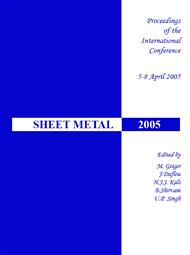p.737
p.745
p.753
p.763
p.771
p.779
p.787
p.795
p.805
Magnesium Sheet Metal Forming Considering its Specific Yield Behavior
Abstract:
In recent years very strong efforts have been undertaken to build light weight structures of car bodies in the automotive industry. Structural technologies like Space Frame, tailored blanks and relief-embossed panels are well-known and already in use. Beside that there is a large assortment of design materials with low density or high strength. Magnesium alloys are lighter by approximately 34 percent than aluminum alloys and are considered to be the lightest metallic design material. However forming processes of magnesium sheet metal are difficult due to its complex plasticity behavior. Strain rate sensitivity, asymmetric and softening yield behavior of magnesium are leading to a complex description of the forming process. Asymmetric yield behavior means different yield stress depending on tensile or compressive loading. It is well-known that elevated temperatures around 200°C improve the local flow behavior of magnesium. Experiments show that in this way the forming limit curves can be considerably increased. So far the simulation of the forming process including temperature, strain rates and plastic asymmetry is not state-of-the-art. Moreover, neither reliable material data nor standardized testing procedures are available. According to the great attractiveness of magnesium sheet metal parts there is a serious need for a reliable modeling of the virtual process chain including the specification of required mechanical properties. An existing series geometry which already can be made of magnesium at elevated temperatures is calculated using the finite element method. The results clarify the failings of standard calculation methods and show potentials of its improvement.
Info:
Periodical:
Pages:
771-778
Citation:
Online since:
May 2005
Authors:
Keywords:
Price:
Сopyright:
© 2005 Trans Tech Publications Ltd. All Rights Reserved
Share:
Citation:


